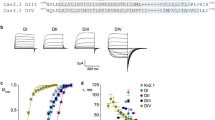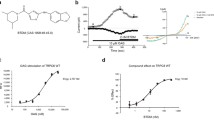Abstract
Ion-conducting channels formed in lipid bilayers by diphtheria toxin are highly pH dependent. Among other properties, the channel's single channel conductance and selectivity depend on proton concentrations on either side of the membrane. We have previously shown that a 61 amino acid fragment of DT is sufficient to form a channel having the same pH-dependent single channel properties as that of the intact toxin. This region corresponds to an a-helical hairpin in the recently published crystal structure of DT in solution; the hairpin contains two α-helices, each long enough to span a membrane, connected by a loop of about nine residues. This paper reports on the single channel effects of mutations which alter the two negatively charged residues in this loop. Changing Glutamate 349 to neutral glutamine or to positive lysine has no effect on the DT channel's single channel conductance or selectivity. In contrast, mutations of Aspartate 352 to neutral asparagine (DT-D352N) or positive lysine (DT-D352K) cause progressive reductions in single channel conductance at pH 5.3 cis/7.2 trans (in 1 m KCl), consistent with this group interacting electrostatically with ions in the channel. The cation selectivity of these mutant channels is also reduced from that of wild-type channels, a direction consistent with residue 352 influencing permeant ions via electrostatic forces. When both sides of the membrane are at pH 4, the conductance difference between wild-type and DT-D352N channels is minimal, suggesting that Asp 352 (in the wild type) is neutral at this pH. Differences observed between wild-type and DT-D352N channels at pH 4.0 cis/7.2 trans (with a high concentration of permeant buffer in the cis compartment) imply that residue 352 is on or near the trans side of the membrane. Comparing the conductances of wild-type and DT-D352K channels at large (cis) positive voltages supports this conclusion. The trans location of position 352 severely constrains the number of possible membrane topologies for this region.
Similar content being viewed by others
References
Cabiaux, V., Brasseur, R., Wattiez, R., Falmagne, P., Ruysschaert, J.M., Goormaghtigh, E. 1989. Secondary structure of diphtheria toxin and its fragments interacting with acidic liposomes studied by polarized infrared spectroscopy. J. Biol. Chem. 264:4928–4938
Choe, S., Bennett, M.J., Fujii, G., Curmi, P.M., Kantardjieff, K.A., Collier, R.J., Eisenberg, D. 1992. The crystal structure of diphtheria toxin. Nature 357:216–222
Hoch, D.H. 1985. Botulinum, Tetanus, and Diphtheria Toxin Channels in Planar Lipid Bilayers. Ph.D. Thesis. Albert Einstein College of Medicine, Yeshiva University, Bronx, NY
Hoch, D.H., Finkelstein, A. 1985. Gating of large toxin channels by pH. Ann. NY Acad. Sci. 456:33–35
Hoch, D.H., Romero-Mira, M., Ehrlich, B.E., Finkelstein, A., DasGupta, B.R., Simpson, L.L. 1985. Channels formed by botulinum, tetanus, and diphtheria toxins in planar lipid bilayers: Relevance to translocation of proteins across membranes. Proc. Natl. Acad. Sci. USA 82:1692–1696
Kagan, B.L., Finkelstein, A., Colombini, M. 1981. Diphtheria toxin fragment forms large pores in phospholipid bilayer membranes. Proc. Natl. Acad. Sci. USA 78:4950–4954
Lehninger, A.L. 1982. Principles of Biochemistry. Worth, New York
Mindell, J.A., Silverman, J.A., Collier, R.J., Finkelstein, A. 1992. Locating a residue in the diphtheria toxin channel. Biophys. J. 62:41–44
Mindell, J.A., Silverman, J.A., Collier, R.J., and Finkelstein, A. 1994. Structure-function relationships in diphtheria toxin channels: III. Residues which affect the cis pH dependence of channel conductance. J. Membrane Biol. 137:45–57
O'Keefe, D.O., Cabiaux, V., Choe, S., Eisenberg, D., Collier, R.J. 1992. pH-dependent insertion of proteins into membranes: Bchain mutation of diphtheria toxin that inhibits membrane translocation, Glu-349----Lys. Proc. Natl. Acad. Sci. USA 89:6202–6206
Romero, M. 1988. The Relationships between Small and Large Conductance Channels Formed by Diphtheria Toxin Channels in Planar Lipid Bilayers. Ph.D. Thesis. Albert Einstein College of Medicine, Yeshiva University, Bronx, NY
Silverman, J.A., Mindell, J.A., Zhan, H., Finkelstein, A., Collier, R.J. 1994. Structure-function relationships in diphtheria toxin channels: I. Determining a minimal channel-forming domain. J. Membrane Biol. 137:17–28
Tocanne, J.F., Teissié, J. 1990. Ionization of phospholipids and phospholipid-supported interfacial lateral diffusion of protons in membrane model systems. Biochim. Biophys. Acta 1031:111–142
Author information
Authors and Affiliations
Additional information
This work was supported by NIH grants AI22021, AI22848 (R.J.C.), T32 GM07288 (J.A.M.) and GM29210 (A.F.).
Rights and permissions
About this article
Cite this article
Mindell, J.A., Silverman, J.A., Collier, R.J. et al. Structure function relationships in diphtheria toxin channels: II. A residue responsible for the channel's dependence on trans pH. J. Membarin Biol. 137, 29–44 (1994). https://doi.org/10.1007/BF00234996
Received:
Revised:
Issue Date:
DOI: https://doi.org/10.1007/BF00234996




